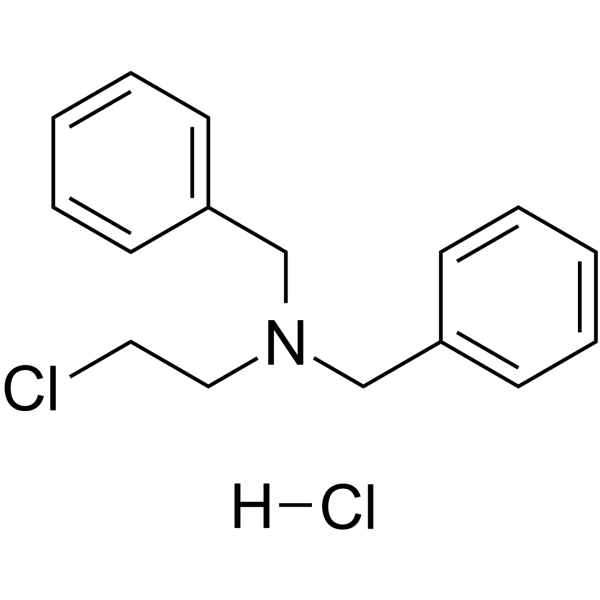
Dibenamine hydrochloride
CAS No. 55-43-6
Dibenamine hydrochloride( N-?(2-?Chloroethyl)?dibenzylamine hydrochloride )
Catalog No. M28152 CAS No. 55-43-6
Dibenamine hydrochloride is a competitive and irreversible blocking agent of the β-adrenergic receptor.
Purity : >98% (HPLC)
 COA
COA
 Datasheet
Datasheet
 HNMR
HNMR
 HPLC
HPLC
 MSDS
MSDS
 Handing Instructions
Handing Instructions
| Size | Price / USD | Stock | Quantity |
| 100MG | Get Quote | Get Quote |


|
| 200MG | Get Quote | Get Quote |


|
| 500MG | Get Quote | Get Quote |


|
| 1G | Get Quote | Get Quote |


|
Biological Information
-
Product NameDibenamine hydrochloride
-
NoteResearch use only, not for human use.
-
Brief DescriptionDibenamine hydrochloride is a competitive and irreversible blocking agent of the β-adrenergic receptor.
-
DescriptionDibenamine hydrochloride is a competitive and irreversible blocking agent of the β-adrenergic receptor.(In Vitro):Dibenamine hydrochloride (100 nM-10 μM) attenuates the extent of cocaine-induced increases in sensitivity to acetylcholine, furthermore, the extent of diphenylamine-induced inhibition depends on the concentration of diphenylamine, which is inversely proportional to the concentration of cocaine. Dibenamine hydrochloride did not have any effect on acetylcholine contraction of isolated guinea-pig vas deferens .(In Vivo):Dibenamine hydrochloride causes a significant increase in the rate of destruction of L-epinephrine in the mouse. Pretreatment with Dibenamine hydrochloride apparently slowed the conversion of Ccl4 to CHCL3. Dibenamine hydrochloride (25 mg/kg; s.c.) decreased the CHCl3, levels at 2 and 6 hr by 30%-50%.
-
In VitroDibenamine (100 nM-10 μM) attenuates the degree of cocaine-induced increase in sensitivity to acetylcholine without any effect on acetylcholine-contraction in isolated vas deferens of guinea pig. Additionally, the degree of dibenamine-induced inhibition dependent on the concentration of dibenamine and inversely related to the concentration of cocaine.
-
In VivoDibenamine hydrochloride (subcutaneous?injection; 25 mg/kg; 48 and 24 hr before the administration of CCl4) decreases the CHCl3, levels at 2 and 6 hr by 30-50 percent, but did not appreciably affect the half-life of CHCl3, in the liver.Pretreatment with Dibenamine apparently slows the conversion of Ccl4 to CHCL3.
-
SynonymsN-?(2-?Chloroethyl)?dibenzylamine hydrochloride
-
PathwayAngiogenesis
-
TargetAdrenergic Receptor
-
RecptorAkt|AP-1|COX|HO-1|MAPK|NF-κB|NO|NOS|Nrf2|p65|PDGFR|PGE|ROS|TNF-α
-
Research Area——
-
Indication——
Chemical Information
-
CAS Number55-43-6
-
Formula Weight296.24
-
Molecular FormulaC16H19Cl2N
-
Purity>98% (HPLC)
-
SolubilityIn Vitro:?DMSO : 125 mg/mL (421.97 mM)
-
SMILESCl.ClCCN(Cc1ccccc1)Cc1ccccc1
-
Chemical Name——
Shipping & Storage Information
-
Storage(-20℃)
-
ShippingWith Ice Pack
-
Stability≥ 2 years
Reference
1.Wu XD, et al. Bioactive sesquiterpenoids from the flowers of Inula japonica. Phytochemistry. 2016 Sep;129:68-76.
molnova catalog



related products
-
Noradrenaline bitart...
orepinephrine is the principal transmitter of most postganglionic sympathetic fibers and of the diffuse projection system in the brain arising from the locus ceruleus.
-
Phentolamine
Phentolamine mesylate is an alpha-1 and alpha-2 selective adrenergic receptor antagonist.
-
Phentolamine Analogu...
Phentolamine Analogue 1 is an analogue of phentolamine. Phentolamine is a nonselective antagonist of α-adrenergic.



 Cart
Cart
 sales@molnova.com
sales@molnova.com


